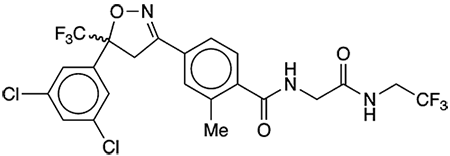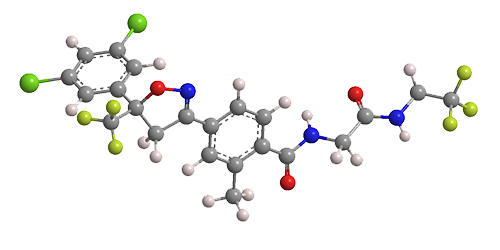What molecule am I?


Spring is finally here. Tennyson wrote, “In the Spring a young man’s fancy lightly turns to thoughts of love,” but these days, a pet owner’s fancy often turns to thoughts of controlling fleas on his or her furry friends.
Many treatments are in use to repel fleas (and ticks) from dogs and cats or to kill the insects once an infestation occurs: Treatments include topical powders and liquids, flea collars, and oral medications. All of these methods have advantages and disadvantages; the Internet is full of arguments for and against each.
In 2014, the US Food and Drug Administration approved the use of fluralaner (trade name Bravecto), a chewable tablet for dogs that is administered at 12-week intervals. This is a significant improvement to oral products that must be taken monthly. Fluralaner is a systemic insecticide that inhibits GABA-gated and l-glutamate-gated chloride channels in the insects’ nervous system.
FDA evidently considered the compounded product Bravecto to be safe enough for general use, but a glance at the hazard information box reveals that fluralaner itself is not to be handled carelessly. The dosage of fluralaner in Bravecto ranges from 112.5 mg to 1.4 g, depending on the weight of the dog to be treated. It can be inferred that even at the highest dose, Bravecto is deemed safe to be handled by the dog’s human companion.
Fluralaner hazard information
| GHS classification*: skin irritation, category 2 | |
| H315—Causes skin irritation | |
| GHS classification: skin sensitization, category 1 | |
| H317—May cause an allergic skin reaction | |
| GHS classification: serious eye damage, category 1 | |
| H318— Causes serious eye damage | |
| GHS classification: respiratory sensitization, category 1 | |
| H334—May cause allergy or asthma symptoms or breathing difficulties if inhaled | |
| GHS classification: specific target organ toxicity, single exposure; respiratory tract irritation, category 3 | |
| H335—May cause respiratory irritation | |
| GHS classification: germ cell mutagenicity, category 2 | |
| H341—Suspected of causing genetic defects | |
| GHS classification: reproductive toxicity, category 2 | |
| H361—Suspected of damaging fertility or the unborn child. | |
| GHS classification: specific target organ toxicity—single exposure, category 1 | |
| H371—May cause damage to organs | |
| GHS classification: Hazardous to the aquatic environment, long-term hazard, category 4 | |
| H413—May cause long-lasting harmful effects to aquatic life | |
*Globally Harmonized System of Classification and Labeling of Chemicals. Explanation of pictograms.
Fluralaner fast facts
| CAS Reg. No. | 864731-61-3 |
| Molar mass | 556.29 g/mol |
| Empirical formula | C22H17Cl2F6N3O3 |
| Appearance | White to off-white crystals or powder |
| Melting point | Not available |
| Water solubility | Insoluble |
MOTW update:
July 16, 2018
Fluralaner is a popular flea medication for dogs that needs to be administered at only 12-week intervals. Now, fluralaner and its cousin flea protectant afoxolaner might be used as an oral medication to kill disease-spreading mosquitoes when they bite treated people. A modeling study by researchers at TropIQ Health Sciences (Nijmegen, The Netherlands) and California Institute for Biomedical Research (La Jolla) found that in areas at risk, giving people these drugs would substantially reduce incidences of malaria and Zika. The drugs kill carrier mosquitoes via an attack on an insect-specific ion channel.

Learn more about this molecule from CAS, the most authoritative and comprehensive source for chemical information.
Molecule of the Week needs your suggestions!
If your favorite molecule is not in our archive, please send us a message. The molecule can be notable for its current or historical importance or for any quirky reason. Thank you!
Stay Ahead of the Chemistry Curve
Learn how ACS can help you stay ahead in the world of chemistry.

